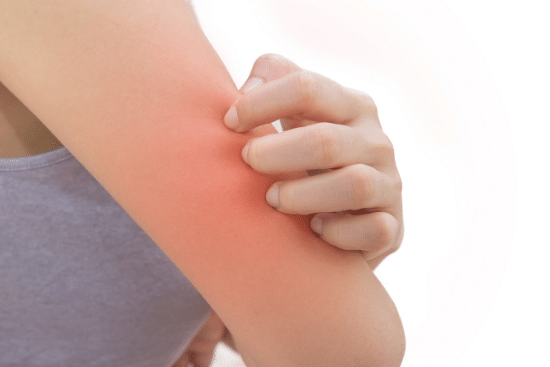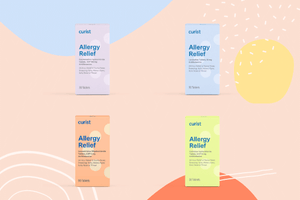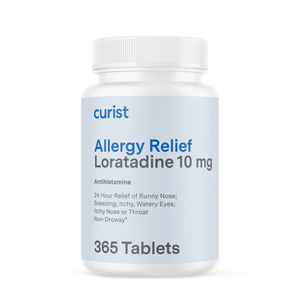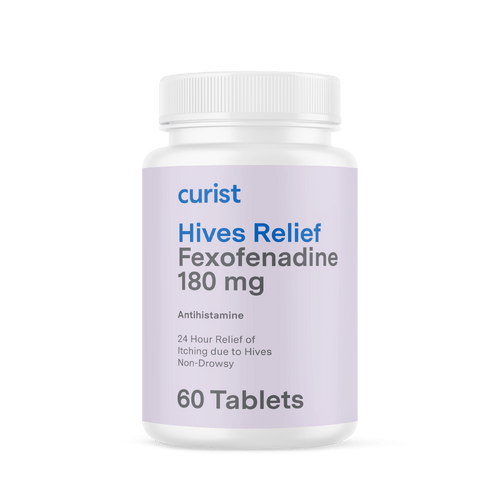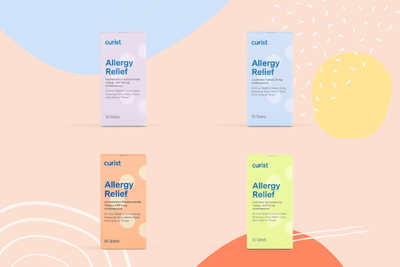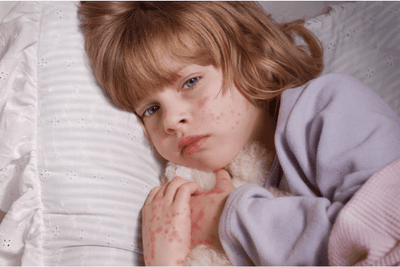Curist delivers over-the-counter medicines to your door at a fraction of the price of traditional brands. We hope everyone stays safe and healthy during this time.
If you were recently outdoors and returned home noticing a red, itchy patch on your skin, you may have an allergic skin rash. Have you ever wondered what an allergic skin rash is, what causes it, and what antihistamines can best treat an allergic skin rash? Continue reading to learn more!
What is an allergic skin rash? What causes an allergic skin rash?
An allergic skin rash is also known as contact dermatitis, which simply means skin inflammation from touching something that makes your body’s immune system overreact. An allergic skin rash may appear when your body comes into contact with an irritant or an allergen causing a patch of your skin to be itchy, red, and inflamed. It can appear within minutes, hours, or several days of coming into contact with the irritant or allergen.
What is the difference between allergic skin rash and non-allergic skin rash?
An allergic skin rash is caused by allergens which cause the immune system in some people to overreact. Some common allergens include plants like poison ivy, jewelry made of nickel, soaps, fragrances, or cosmetics. It is even possible to develop an allergy over time to things you have used before!
On the other hand, non-allergic skin rashes are caused by irritants, which are substances that would cause an immune system response with anyone who comes into contact with it. Common irritants like permanent hair dyes, harsh detergents, or chemicals can cause a non-allergic skin rash which typically results in a painful skin rash that appears quickly after contact.
In both cases, the skin symptoms are most severe where you touch the allergen or irritant. If you want to know what substances may be causing your skin rash, you can see an allergist for a skin patch test, where they will help you identify the problematic substances. It will help your doctor if you write notes with details surrounding the skin rash such as where it touched your skin, how much of the substance you encountered before the reaction, and any activities 1-2 days before the skin rash appeared.
What are the common types of allergic skin rashes?
The two most common types of allergic skin rashes are hives (urticaria) and eczema:
- Hives (Urticaria) appear on the skin as red, raised bumps that are usually itchy, burning or stinging. Hives can result from an insect sting, pollen (like appear in spring allergy season or fall allergy season), pet dander (like that from dogs or cats), medications such as those for high blood pressure, antibiotics, or aspirin as well as certain fresh foods like nuts, fish or eggs.
- Eczema (Atopic Dermatitis) is a more long-term sensitivity to environmental allergens that generally appears around the eyes, feet, hands, inside of elbows, and back of knees as cracked, inflamed, red, itchy, dry skin patches. Eczema can flare up from time to time and can happen with seasonal allergies.
What is the best way to avoid an allergic skin rash?
The best thing you can do to prevent an allergic rash is to avoid contact with the allergen or irritant that causes the skin irritation. So if you think you will be exposed to something that will cause an allergic skin rash, wear protective clothing or gloves. If you do come into contact with the allergen or irritant, wash your skin immediately with warm water and mild, fragrance and dye-free soap. Pat the area dry and use a cool, wet compress to calm the area.
It is also best to avoid scratching the irritated, red skin as it can lead to a possible open wound that can get dirty and infected. You can use fragrance-free moisturizers or anti-itch creams like hydrocortisone or calamine to soothe your skin.
Can antihistamines help allergic skin rashes?
During an allergic reaction, your body’s immune system releases natural chemicals called histamines that cause itchy red, inflamed skin. Although it will take time for your body to naturally heal, antihistamines can help relieve the itching associated with skin rashes like hives and eczema. Try your best to avoid scratching the allergic skin rash, because if you open a wound, it can lead to an infection and even longer healing process. Use antihistamines, fragrance-free moisturizers, or anti-itch creams like hydrocortisone or calamine to relieve the itchiness and soothe the irritated skin.
How long does it take for an allergic skin rash to go away with antihistamines?
Typically an allergic skin rash will appear within minutes or hours after your contact with an irritant and the itching symptoms will go away within two to four weeks. An allergic skin rash is limited to the area of skin in contact with the trigger. Use of antihistamines may not reduce the amount of time it takes for the skin rash to go away, but antihistamines will help reduce the itching while you have the rash. If the allergic skin rash does not resolve within a couple weeks or if it worsens over time, you should contact your healthcare provider for evaluation.
Which antihistamine is best for allergic skin rashes?
The best antihistamine to take during the day to help with allergic skin rashes is Curist Allergy Relief (levocetirizine) or another antihistamine like fexofenadine or loratadine, which can provide 24-hour symptom relief without making you feel sleepy. For better symptom relief at night, you may use a first-generation antihistamine like benadryl, which can reduce your itchiness and help you sleep. These antihistamines can help you relieve the discomfort and itchiness of the allergic skin rash while your body heals the skin.
Will an antihistamine treat both itching and rash?
The good news is that an oral antihistamine tablet like levocetirizine (brand Curist) can help relieve the itchiness and discomfort from a rash; however, you will need to let your body heal the rash with time. In addition to an oral antihistamine, an anti-itch cream or moisturizer on your skin can help soothe any red, irritated skin and help you avoid the urge to itch. Scratching the rash could open the wound, allow it to get dirty, and lead to an infection, which will take additional time to heal and possibly require additional medications.
If you think you will be exposed to something that will cause an allergic skin rash and it cannot be avoided, you can take antihistamines (levocetirizine, fexofenadine, or loratadine) beforehand to help prevent symptoms. For instance, taking antihistamines before visiting your friend who has a cat or dog, can reduce the itching and rash from hives produced from contact with the pet’s dander.
